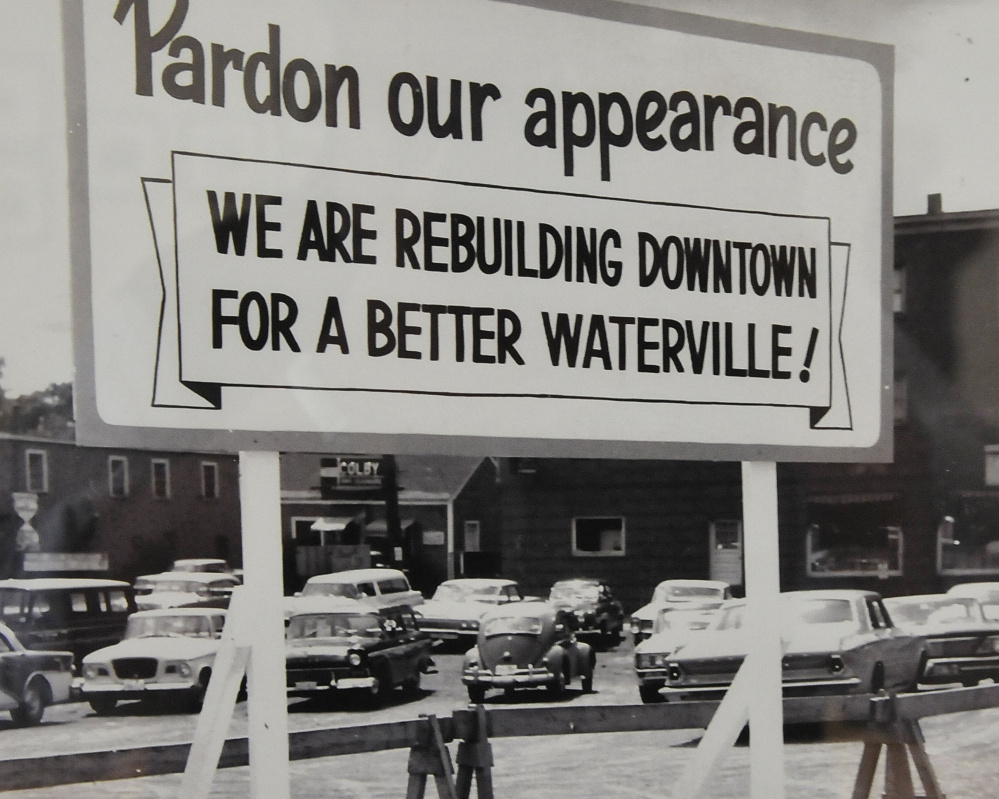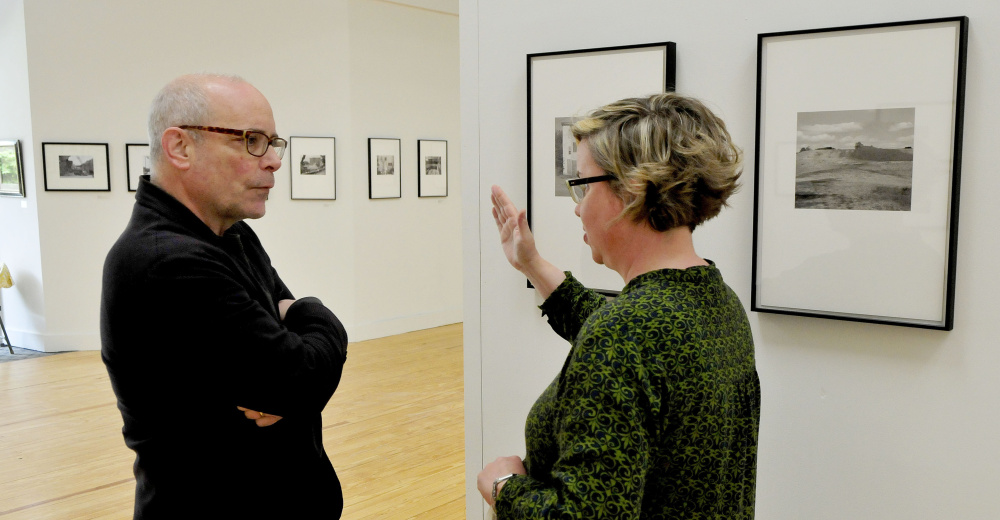WATERVILLE — It was a stormy day in 2007 when Gary Green toured Waterville with local author and historian Earl Smith and the late Willard B. Arnold III, former president of the Waterville Historical Society, who knew intimately every nook and cranny of the city and its past.
Green, associate professor of art at Colby College, had just arrived in Waterville. The acclaimed photographer was fascinated by the places Smith and Arnold took him — the former Colby campus off College Avenue, the railroad tracks, the Kennebec River and other places that define the city.
“They picked me up at Colby and it was pouring rain,” Green recalled. “We just drove around, and they told me different things to look for and told me about the willows that were on the old campus.”
Over the next 10 years Green took hundreds of black and white photographs as he traveled around the city — and sometimes he re-photographed certain places if they had changed. He shot facades of neighborhoods, changes in downtown, interiors of buildings such as the former Boys & Girls Club off Main Street, the interior of St. Francis de Sales Catholic Church on Elm Street before it was demolished, and the eventual razing of the church.
A fraction of those photos are part of “Elm City,” a series on display at Common Street Arts that is part of a larger exhibit, “Picturing Waterville,” which also includes historical photos of the city on loan from the Waterville Historical Society. The exhibit, which is free and open to the public, opens Wednesday and continues to July 1. An opening reception to which the public is invited will be 5 p.m. to 7 p.m. Thursday at Common Street Arts, located on the first floor of The Center at 93 Main St. downtown.
“It’s so timely with so much that’s going on here in Waterville with revitalization,” said Nate Towne, marketing manager for Waterville Creates!, of which Common Street Arts is a part. “The shape of the city as we know it is rapidly changing.”
Patricia King, vice president of programming and operations for Waterville Creates!, said the exhibit is for, by and about the community and includes the artist’s perspective as well as the historical perspective.
“I hope the show allows people to start talking about what’s happening here and how they can be involved,” King said Monday at the gallery. “That’s what this show is about — to enhance engagement about community efforts, continue the dialogue, let people feel like they have the ability to participate.”
The exhibit includes photographs of landscapes, revitalization, construction and urban renewal work from the 19th Century to the present. In conjunction with the exhibit, a photography project called “snap,” in which community members were invited to submit photos of a building, landscape, streetscape or other setting in Waterville that has special meaning for them, will be on display. People walking on Main Street downtown will be able to view the photos on a video that will run continuously in the window of The Center, as well as through social media. People are encouraged to submit photographs for the project.
“It’s going to be ongoing,” Towne said, “and it’s going to evolve as the city does. I don’t think the exhibit will end this year. I think we’ll see this art exhibit continue to future years.”
Also as part of “Picturing Waterville,” a special project, “Photography and Migration: Waterville Stories,” will be on display in an adjacent gallery at Common Street Arts. The project includes photographs and associated narratives by area residents who shared their family photos and migration stories at a recording session held April 22 at Waterville Public Library. Participants were videotaped as they spoke of their families arriving in Maine, as well as of their cultural heritage, and the roles photos play in preserving that heritage. Along the walls of the gallery are large reproductions of vintage Waterville photos donated to Colby. King said the project is an extension of the “Photography and Migration Project,” founded by Tanya Sheehan, the William R. Kenan Jr. Associate Professor of Art and chairwoman of the art department at Colby.
Sheehan and her students collected stories for the project, according to King.
“Whether you came five years or 50 years ago, you were invited to tell your story about migrating to Waterville,” King said.
Also as part of the exhibits are several free events to which the public is invited, including a workshop in pinhole photography from 1 p.m. to 3:30 p.m. Saturday at Common Street Arts featuring Johanna Moore and sponsored by Colby’s Center for the Arts & Humanities; Urban sketching, from 10 a.m. to noon June 10 with artist Helene Farrar, also sponsored by the Colby Center; downtown walking tours with Paul Ureneck, who oversees downtown revitalization projects, from noon to 1 p.m. June 14 and 28; and a community panel and discussion with Green, Sheehan, Smith, and Sarah Sugden, director of Waterville Public Library and curator of the historical society, at 2 p.m. June 17 at Common Street Arts. They will explore how photography can activate shared experiences in the 21st century, particularly in communities undergoing social and economic transformation.
“The public is warmly invited,” King said. “This exhibit is really a collaboration between people like Gary, the public library, historical society, Center for the Arts & Humanities. It took a lot of organization and participation to get this to come together. We want it to feel like it’s community participation and engagement around this revitalization, past and present.”
Shannon Haines, president and chief executive officer of Waterville Creates!, said the exhibit exemplifies the kind of programming the organization seeks to support — high quality, accessible, relevant and extremely collaborative.
“We are so excited to be working with the Waterville Historical Society, the Waterville Public Library and Colby to present this exhibition and related events designed to engage community,” she said.


WATERVILLE, IN PICTURES
At the Common Street gallery Monday, Green and King were working to label framed photographs on the gallery walls overlooking Castonguay Square in the city’s center. Mixed with Green’s more contemporary photos are those representing Waterville’s past.
There are photographs of icons inside the former St. Francis de Sales Church before it was demolished, a vast, empty room in the former C.F. Hathaway Co. mill, demolition of the former Levine’s store on Main Street, an empty swimming pool inside the former Boys & Girls Club, the former Charles Street downtown where the Concourse is now located and old cars along Main Street downtown in 1950.
There are also photos of wigs atop mannequins in the former Hains building which Colby is renovating, construction of the post office at Post Office Square in 1911 and the former Elmwood Hotel that once stood large at the intersection of College Avenue and Main Street.
Green has been teaching photography 23 years, and his photographs have been shown at many universities, libraries and museums including the Museum of Fine Arts in Houston, Texas; Bates, Bowdoin and Colby College museums of art; Portland Museum of Art; and Paolo Baldacci Gallery in New York City. He has a master’s degree in fine arts from The Milton Avery Graduate School of the Arts at Bard College.
Green said he photographed places in Waterville that changed from day to day and year to year and now downtown revitalization represents a big change — a sea change. He continues to shoot photos as opportunities present themselves.
“It’s intermittent, when I have time, when the light is right,” he said. “Now, it’s when I see something related to what I have already photographed or when I see something new happening.”
The exhibit, he said, in some ways represents many places that have changing landscapes, constantly in flux.
“There’s no standing still, whether things are good economically or bad economically,” he said. “The landscape changes. The more you look at a place, the more you can see. I get to look at it intimately, just about every single day. The more you look at a place, the more you know it, the more you see the things that are particular to it. Waterville is kind of special. It is a river town. It’s Maine. It has a regional landscape. It still has its old facades and its older buildings — a rich immigrant community, a rich history. That’s important to me.”
As King and Green worked in the gallery, Thomas College graduate Victoria Cushing, 20, rolled white paint on a large block that will hold the video screen for the “snap” exhibit.
A summer intern at Waterville Creates!, Cushing, of New Sharon, said she has been learning a lot and enjoying her work with Green, King and others, helping write press releases, frame photos and prepare for the photo exhibit.
“I did a photography class in high school so it’s kind of cool to go back to that,” she said. “I think I’ve learned probably the most about the town of Waterville itself through old pictures of places. It’s really interesting.”
People of any age may submit photos for the “snap” project by going to www.facebook.com/snapwtvl. Digital photos may be submitted electronically at submit@commonstreetarts.org Those wanting to register for the pinhole photography and urban sketching workshops are asked to call 872-ARTS.
Amy Calder — 861-9247
Twitter: @AmyCalder17
Send questions/comments to the editors.






